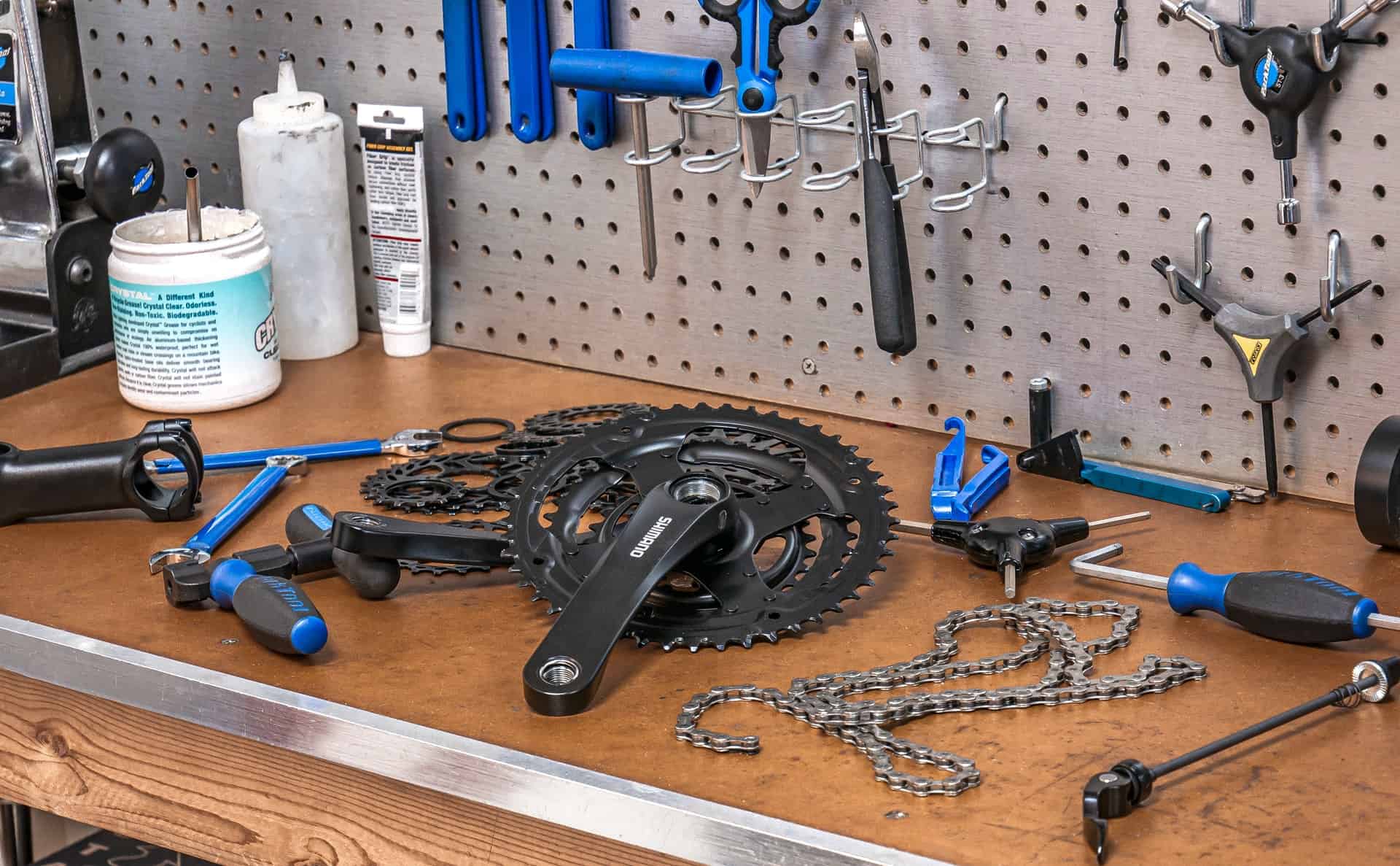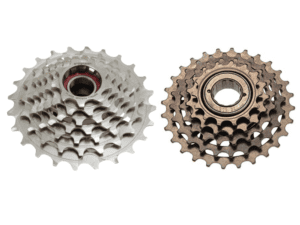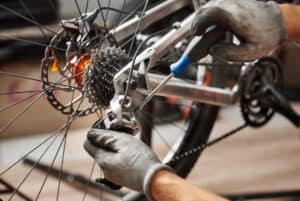When it comes to your bike, it’s always essential to have some DIY skills up your sleeves.
Your bike mech could be hundreds of miles away from you when you need him the most. Without him or an idea of how to fix a chain on a mountain bike, having a slipped or snapped chain can turn out to be your worst nightmare.
So here’s a step-by-step guide to fix a chain on a mountain bike. Plus, we’ll cover what causes chain issues, and how to tell whether your chain has served its time.
How to Fix The Chain
What you need:
- Chain tool
- A pair of latex gloves
- The will or need
All you need when fixing a chain is the chain tool. It pushes or pulls the link in your chain.
A chain tool can come as a separate tool or with a set of Allen keys. Some cyclists have had a chain tool with no idea of its use. They’ve never used it before and will probably never have to.
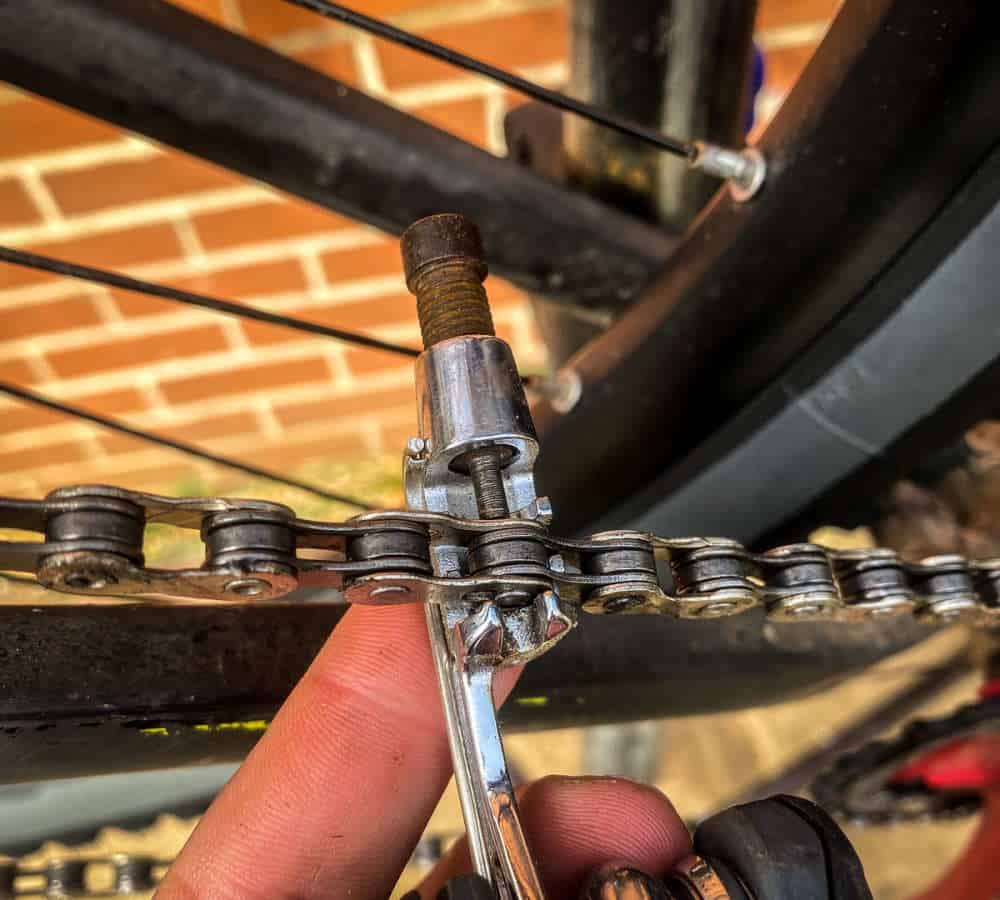
The chain tool is the right tool to repair or fix your chain, but if you don’t have one, a hammer and a pair of pliers will do the job.
Just be careful not to bang your chain and be forced to go back to the bike store to buy a new chain.
Some bikes come with chains that have quick links. They make it easier for you to remove your chain whenever you want if you are the type of rider that removes the chain quite often.
Here’s the process of fixing your chain.
1. Downshift the Chain

To make your work easier when fixing the chain, you’ll want to make sure that the rear derailleur does not stretch.
Otherwise, your chain will keep on running from your hands immediately after you loosen your grip.
Hang your bike or turn it upside down. Use the left shifter to downshift the chain to the lowest or smallest chainring.
Lower the rear as well, and ensure the chain is sitting on the smallest cog. This will help to realign the chain. If using a 1x drivetrain, lower the chain on the rear to the smallest cog. This makes the derailleur less tight.
2. The Issue You Are Trying to Solve
Is your chain worn out and keeps slipping off and making that annoying “grrr” sound? That calls for a new chain, so you better have a new KMC, SRAM, or HG chain with you.
The chain should be the same speed as your cassette or higher. For instance, if you are running on a 10-speed, the chain should be ten or 11-speed.
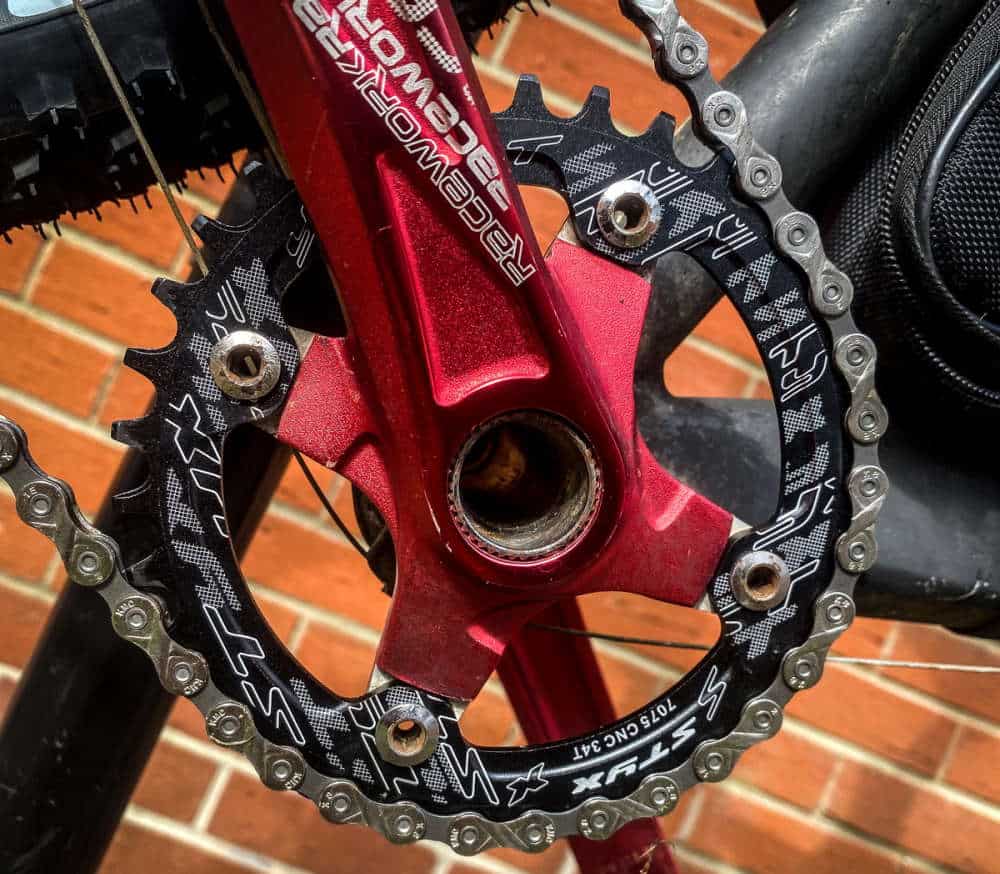
Experiencing a slipping chain, yet the chain looks almost new with so much life left? Your chain is probably too long, and you’ll need a chain breaker or a chain tool. .
Use the chain tool to push the link out, and do the same on the third link, depending on how short you want your chain to be. Be careful not to move the link out. You can also shorten the bike’s chain without these tools but that takes a tad more effort
Trying to take your chain off the bike? It could be clogged with dirt. The exact process applies.
Grab your chain tool, push the link halfway out, clean your chain, and put it back on by moving the link back in. If your chain has a quick link, you can do this hassle-free.
3. Take a Look at the Chain
You wouldn’t be here if you didn’t have an issue with your chain, and hopefully, you already know what the problem is.
It’s time to have a closer look at your chain. Your bike should be flipped upside down all this time, or you can heighten the bike on the bike stand.
This is to make it easier for you to reach the chain. You don’t want to bend too much and hurt your back.
Let’s assume your chain broke. Fixing a chain is the dirtiest job ever, so make sure you don’t mind staining your shirt or pants.
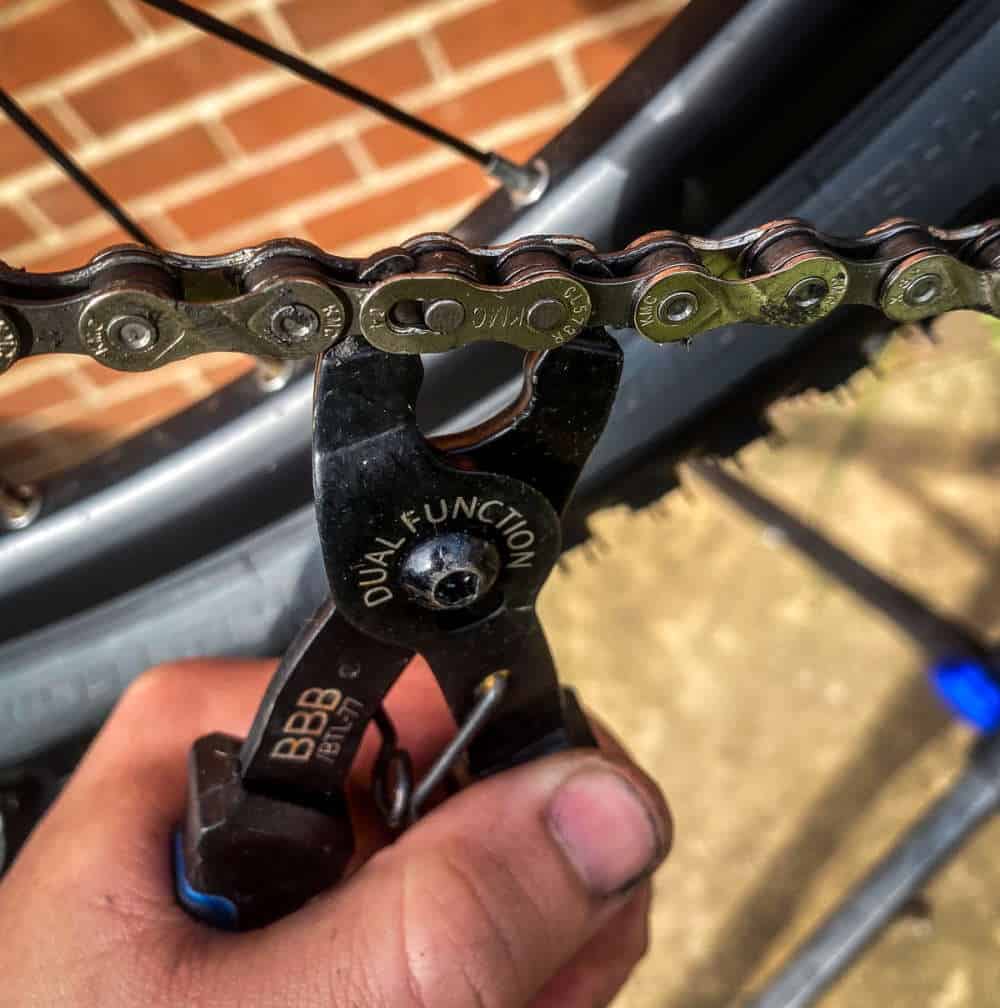
When a chain breaks, there are two things involved. The link may remain there, or in a rare case, it might shoot like a bullet, never to be seen again. If it remains there, good for you. You’ll have an easy job fixing the chain back.
Suppose the link is propelled like a grenade to where God knows where, you’ll have to be more technical.
Take a look at both ends and the segment you see on one side, you’ll have to remove it using a chain tool.
You’ll need to remove another set of segments because they usually alternate. Removing one segment will be as useless as trying to fill the air in your bike tubes with your mouth.
Once you remove the two segments, be sure to leave one end with a link. Place the chain in the middle of your chain tool, and rotate it to push the link downwards towards the center to re-attach the chain.
4. Remember to Guide the Chain Through the Rear Derailleur
If you are not careful, you might fix your chain only to realize you forgot something and have to redo the whole thing all over again.
Chains get off the rear derailleur every time you hear a snap. Getting the chain back means pulling it between the rear derailleur and the front derailleur correctly before putting the chain tool on it.
Re-feed the chain through the pulleys properly, making sure that from under the cassette, the chain runs over the guide pulley, also known as the top pulley, passes between the derailleur’s skeleton to the back of the tension pulley, which is the lowest pulley on the edge of the derailleur.
The chain should go through the cage on the tip of the derailleur. Ensure the chain has gone through the front derailleur as well with the other end before re-attaching it.
Guide on Buying a Chain For Replacement
When buying a new chain, in case you have to replace your current chain after it has worn out, there are a few things to consider, namely:
- The type of bike you ride
- The speed of the chain
- The length of the chain
Chains come in different widths and lengths for different types of bikes. I’ve seen road bike chains working just fine with MTB drivetrains, but you have to remove a couple of segments for the chain to fit. Here’s what to consider when buying a chain.
1. Compatibility
A Shimano chain is compatible with SRAM cassettes and vice versa, but both of these are not compatible with Campagnolo cassettes. The chains from KMC are compatible with Shimano and SRAM cassettes.
2. Know When You Need A Chain
Whenever you start pedaling, your chain, cassette, chainrings, and the jockey wheels slowly eat each other up. It may take years for them to wear out and require replacement. Depending on how long you have been riding the bike, and the quality of your drivetrain, you will have to buy a new chain after some time.
Lubing your chain helps to extend the lifespan of your chain before replacing it. As time goes by, the chain tends to stretch. It may also expand around the rollers. If you notice that your chain is skipping, this could be the reason, and you may have to buy a new chain.
3. The 2,000-Mile
It’s common knowledge in the cycling world that if Strava shows that you have ridden over 2,000 miles, your next ride should be to the bike shop for a new chain. It’s a general rule, but it doesn’t mean that all chains should be replaced after 2,000 miles.
However, you should know that’s the average distance your chain is supposed to go, and there will be no surprises when your chain starts acting funny.
If you like using hard gears, hardly clean your chain, and don’t give a damn of what the weatherman has to say, 2,000 miles will be nothing but a dream.
Have you been showing your chain lots of love? 2,000+ miles will be your reward. If not, start counting those dollars that you’ll have to part with for a new chain.
4. The Qualities of a Good Chain
A high-end chain reacts to gear shifting swiftly and effortlessly and with smaller lamps to ensure the chain jumps from one cog to another or from one chainring to the other.
When adequately lubed, the rollers make the chain more flexible and shifting easier.
A high-quality chain is made of alloy steel. The material is durable and can withstand the pulling associated with pedaling.
So, when going for a chain, ensure to get a high-quality chain. It’s for the sake of longevity and to be kind to your cassette and cranks.
How Do Chains Work?
A chain is made of segments, inner and outer, inner and outer, in that order. Each segment is held to the other by a pin or peg.
Your chain tool removes one of these pins to detach the chain. To fix a chain, you’ll be required to remove a link, a whole segment, maybe two, then re-attach.
For a single-speed chain, removing a segment might make the chain shorter and useless.
If you use the derailleur option, you have a couple of segments you can compromise before running out of options. You can also use links from an old chain or get a new one.
To determine the right length of your chain, especially when replacing the current with a new pair, you can measure both chains against each other and minimize the new one to the length of the older one. Chains come long to fit different-sized bikes.
Why Should You Be Concerned about the Chain?
Your bike chain is part of the drivetrain, and without it, you cannot propel the bike unless you push it.
What’s the need for a bike in the first place if you are to push it? Though often overlooked, the chain remains one of the most vital parts of the bike.
You hardly notice its role when it’s working just fine, but when it develops issues, you will not know peace until you have it fixed.
It would be best to be concerned about your chain because it’s one of the most crucial components that complete your bike.
Just take a look at your current chain, and ask yourself, have you been returning the love it shows you by using the right chain lube or any of these chain lube alternatives? Do you clean it after every ride?
Do you love it sparkling clean? You should always have a person-to-person relationship and inspect the chain for wear every while. Proper care of the chain ensures that your chain lasts longer.
Chain Maintenance
Someone may have told you that an unmaintained chain will give you so much headache.
Not only does it make your riding feel stiff and your bike look untidy, but it also means you’ll have to replace your chain, chainrings, and cassette sooner than you are supposed to.
It’s a no-brainer that every moving part of your bike should get the attention it deserves.
Cleaning your chain and lubing it increases longevity, improves the drivetrain performance, offering quieter and smoother shifting and pedaling. We have a guide on chain maintenance and cleaning with all the information needed.
Perhaps the most brilliant move you can make is to buy a whole bike cleaning set to help you clean mud, wash the gunk from old oil, and degrease your chain.
A bike is like your body system. You feel dull and bored whenever you catch a fever. The quality of your ride decreases when your bike is not in any good condition.
Make it a norm to take care of your bike chain and the entire bike, including servicing it.
Possible Reasons why Your Chain is Coming Off
- The drivetrain has served its tenure and needs replacement ASAP.
- The chain is clogged with gunk from old oil and dirt and mud collected on the rides.
- The chain has stretched or expanded.
- Excessive slanting of the chain.
- A wrong-sized chain, making it hard for the chain to settle on the cassette.
- The chainring tooth or a chainring is bent.
- The chain is not compatible with the cassette.
- The clutch of your rear derailleur, which helps adjust the tension, has failed.
- The rear derailleur hanger is bent, and you need a new one.
- The rear derailleur is not aligned correctly.
- You pedaled too hard, and the chain came off due to the pressure.
- Backpedaling when shifting and the chain came off.
- The front derailleur also is not aligned correctly.
- You hit a big bump or crashed, and the chain came off due to the impact.
- The rear derailleurs pulleys are out of order, worn out, or dirty.
All these are possible reasons why your chain can come off. The issue doesn’t have to be with the chain, and you may not have to replace or detach it.
However, if your chain has stretched, expanded, is slanting excessively, or isn’t compatible with the cassette, you’ll need to buy a new chain.
FAQs
Q: How do I fix my mountain bike chain?
A: It’s very simple. Grab a chain tool, use it to push the link, and the chain will be attached. This is the general way of fixing your chain.
Q: How do you fix a broken bike chain?
A: Remove two segments if you lost the link. If you still have the link and the segments are in good order, you only have to re-attach it back with the chain tool. You can also decide to use a quick link if you have it.
Q: How do you reconnect a bike chain?
A: You can reconnect a bike chain by driving in the link with the chain tool. The chain tool also flattens the crown of the chain so that it never comes out. A loose link can detach when you apply pressure.
Q: How do I reset my mountain bike chain?
A: Lift the chain onto the chainring. Turn the pedals with the rear wheel lifted from the ground. The chain will slowly pick the position dictated by the derailleur.
Q: Why did my mountain bike chain break?
Your bike chain broke probably because of wear and tear, gear shifting under a heavy load, or poor maintenance. Other reasons could be due to worn-out cogs or chainrings. The last reason could be because you are using the wrong links.
Q: How much does it cost to fix a broken bike chain?
A: if you are talking about replacement, prepare to spend $15 on an entry-level chain and $25 to $60 for a higher performance one. New chains improve shifting quality, and the most expensive ones are more durable.
Q: How do I fix my bike chain without the master link?
A: You have three options available. The first one is removing a link from your older chain. The second one is removing two segments from one end of the chain. The third option is to buy a link.
Final Remarks
If you change your chain and it continues slipping, your cog or chainrings are probably worn out.
Just pass by the mechanic and have them examine your bike to find the problem. They’ll be able to advise you further. If you have any questions, kindly contact us for assistance.
